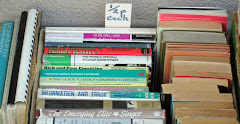 |
| Hugh Buchanan at Summerhall |
.JPG) |
| Packet No 12 Forchtenstein Photo courtesy of Hugh Buchanan |
Old receipts, rental agreements, and ledgers may not sound enticing but these are so exquisitely painted, they are things of beauty. Gothic German calligraphic inscriptions, old crests and seals are rendered accurately,and so are the subtle tones of marbled papers in wavering colours of russets, peach and old tallow but far from being a painstaking reproduction, Hugh Buchanan's water-colours evoke the play of light and dust, the texture of the paper, (he will even use sand-paper to achieve this) and the atmosphere of private libraries in castles and stately homes. I could not help thinking of mortality, not only because of the torn, yellowing and crumbling paper depicted but because these archives are people's lives, not epic historical achievements, but the minutiae of daily, domestic balance sheets.
There was also a selection of water-colours of the archives of Drumlanrig Castle near Dumfries; and the old library at Traquair House, in the Borders (famed for its system of labelling the shelves and spines (e.g. Pythagoras, shelf 1, book 14). Old country houses, stately homes and castles are the best places to find undisturbed archives, Hugh told me. Libraries are apt to organize everything into perspex boxes which do not make such atmospheric paintings.
Old country houses and castles have long been Hugh's haunt. When at Edinburgh Art School he specialized in painting architectural spaces and since then he has had a prestigious career. His works are in the collection of the Queen, the Queen Mother, HRH the Prince of Wales, the Palace of Westminster, the City of Edinburgh and the V and A among others. Painting the interior of houses such as Highgrove and Balmoral, surrounded by beautiful architectural spaces, including old private libraries led to his present interest in archives.
His subject matter was of course ideal for an exhibition during a Festival of Historical Fiction but he told me later that the Esterhazy watercolours (though not Drumlanrig and Traquair ones) will continue, not in the 'ballroom' but another room in Summerhall and on the walls surrounding the main staircase throughout the summer. So if you love old books, and parchments, do try and see it. Even if you can't read the contents, you can imagine them and the people they are about.
I recommend A.N. Wilson on Hugh's work 'Enlightenment and the Library Paintings of Hugh Buchanan' (2008) which you can find on Hugh's website, and read more about his illustrious career. You can also discover other intriguing bits of information such as Hugh's collaboration with Peter Davidson, 'The Eloquence of Shadows' (Thirdpart Publications, 1994) which must be the most unique book of its year. Hugh's water-colours and Peter's verse - in contemporary Latin with English translations, such as:
LVX TACET. LOQVITVR VMBRA.
Light is silent, the shadow eloquent.
For more info and photos of art work see http://www.hughbuchanan.co.uk/biography.html
